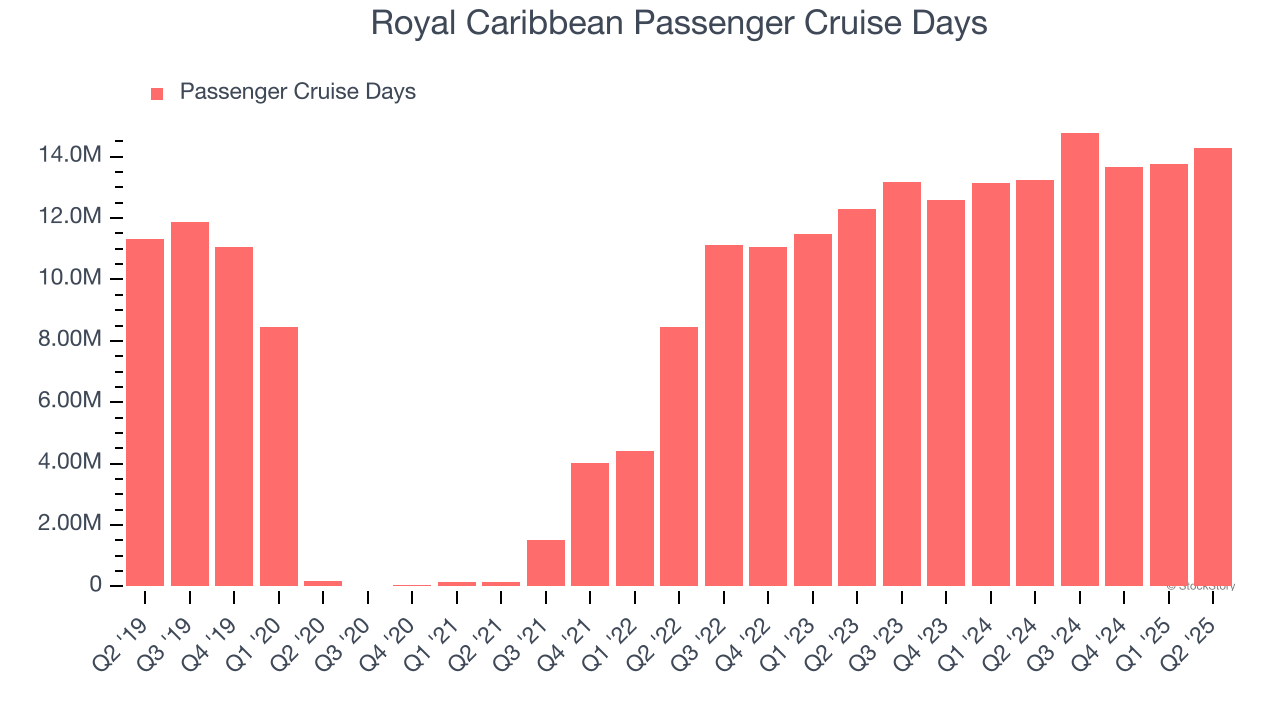
The past six months have been a windfall for Royal Caribbean’s shareholders. The company’s stock price has jumped 41.5%, hitting $345.49 per share. This run-up might have investors contemplating their next move.
Is there a buying opportunity in Royal Caribbean, or does it present a risk to your portfolio? See what our analysts have to say in our full research report, it’s free.
Why Is Royal Caribbean Not Exciting?
Despite the momentum, we're cautious about Royal Caribbean. Here are three reasons why RCL doesn't excite us and a stock we'd rather own.
1. Weak Growth in Passenger Cruise Days Points to Soft Demand
Revenue growth can be broken down into changes in price and volume (for companies like Royal Caribbean, our preferred volume metric is passenger cruise days). While both are important, the latter is the most critical to analyze because prices have a ceiling.
Royal Caribbean’s passenger cruise days came in at 14.28 million in the latest quarter, and over the last two years, averaged 11% year-on-year growth. This performance was underwhelming and suggests it might have to lower prices or invest in product improvements to accelerate growth, factors that can hinder near-term profitability. 
2. Projected Revenue Growth Is Slim
Forecasted revenues by Wall Street analysts signal a company’s potential. Predictions may not always be accurate, but accelerating growth typically boosts valuation multiples and stock prices while slowing growth does the opposite.
Over the next 12 months, sell-side analysts expect Royal Caribbean’s revenue to rise by 9.5%, a deceleration versus its 16.8% annualized growth for the past five years. This projection is underwhelming and implies its products and services will see some demand headwinds.
3. Previous Growth Initiatives Haven’t Impressed
Growth gives us insight into a company’s long-term potential, but how capital-efficient was that growth? A company’s ROIC explains this by showing how much operating profit it makes compared to the money it has raised (debt and equity).
Royal Caribbean historically did a mediocre job investing in profitable growth initiatives. Its five-year average ROIC was 1.2%, lower than the typical cost of capital (how much it costs to raise money) for consumer discretionary companies.
Final Judgment
Royal Caribbean’s business quality ultimately falls short of our standards. Following the recent rally, the stock trades at 20.7× forward P/E (or $345.49 per share). This valuation is reasonable, but the company’s shakier fundamentals present too much downside risk. We're pretty confident there are more exciting stocks to buy at the moment. Let us point you toward the most entrenched endpoint security platform on the market.
Stocks We Would Buy Instead of Royal Caribbean
Donald Trump’s April 2025 "Liberation Day" tariffs sent markets into a tailspin, but stocks have since rebounded strongly, proving that knee-jerk reactions often create the best buying opportunities.
The smart money is already positioning for the next leg up. Don’t miss out on the recovery - check out our Top 5 Growth Stocks for this month. This is a curated list of our High Quality stocks that have generated a market-beating return of 183% over the last five years (as of March 31st 2025).
Stocks that made our list in 2020 include now familiar names such as Nvidia (+1,545% between March 2020 and March 2025) as well as under-the-radar businesses like the once-micro-cap company Kadant (+351% five-year return). Find your next big winner with StockStory today.
StockStory is growing and hiring equity analyst and marketing roles. Are you a 0 to 1 builder passionate about the markets and AI? See the open roles here.
